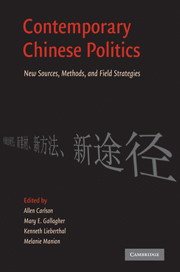Book contents
- Frontmatter
- Contents
- Tables and Figures
- Contributors
- Abbreviations
- Introduction
- Part I Sources
- Part II Qualitative Methods
- Part III Survey Methods
- 10 A Survey of Survey Research on Chinese Politics
- 11 Surveying Prospects for Political Change
- 12 Using Clustered Spatial Data to Study Diffusion
- 13 Measuring Change and Stability over a Decade in the Beijing Area Study
- 14 Quantitative Research and Issues of Political Sensitivity in Rural China
- Reflections on the Evolution of the China Field in Political Science
- Glossary
- References
- Index
12 - Using Clustered Spatial Data to Study Diffusion
The Case of Legal Institutions in China
Published online by Cambridge University Press: 05 June 2012
- Frontmatter
- Contents
- Tables and Figures
- Contributors
- Abbreviations
- Introduction
- Part I Sources
- Part II Qualitative Methods
- Part III Survey Methods
- 10 A Survey of Survey Research on Chinese Politics
- 11 Surveying Prospects for Political Change
- 12 Using Clustered Spatial Data to Study Diffusion
- 13 Measuring Change and Stability over a Decade in the Beijing Area Study
- 14 Quantitative Research and Issues of Political Sensitivity in Rural China
- Reflections on the Evolution of the China Field in Political Science
- Glossary
- References
- Index
Summary
As Manion details in Chapter 10 of this volume, social scientists with an interest in China already have contributed a healthy stream of survey research based on national probability samples, but the methodology behind these surveys has historically been dependent on the household registration system, or hukou (户口 ). Since the 1950s, Chinese households have (in principle) been listed exhaustively by village or urban neighborhood; for decades, local officials took great care to maintain and update these lists. This system was an efficient collection of population data, and household registration lists have thus been widely used as the basis of the vast majority (if not all) of probability samples drawn in China since 1978.
China’s rapid economic transformation has dramatically undermined the key assumption that hukou lists are accurate and complete representations of the population of their respective localities. Until the early 1990s, reasonably reliable lists of residents could still be obtained from villages and neighborhoods, but China’s rapid industrialization and urbanization have severely undermined the ability of local officials to track their populations effectively. As a result, survey researchers who sample the countryside face the problem of drawing respondents who, according to official lists, live in a village but in reality have become urban residents; yet, if researchers sample from urban hukou lists, they will often discover that migrants are not properly listed unless they happen to hold a formal temporary registration. Given the magnitude of recent internal migration in China, the problem is severe. We can no longer claim that samples drawn from hukou lists are representative of the population in a given locality. Nor can we claim that such samples are probability samples.
- Type
- Chapter
- Information
- Contemporary Chinese PoliticsNew Sources, Methods, and Field Strategies, pp. 219 - 235Publisher: Cambridge University PressPrint publication year: 2010
- 1
- Cited by



